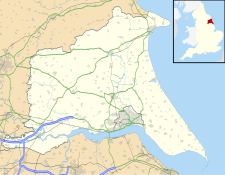
The Royal London Hospital is a large teaching hospital in Whitechapel in the London Borough of Tower Hamlets. It is part of Barts Health NHS Trust. It provides district general hospital services for the City of London and Tower Hamlets and specialist tertiary care services for patients from across London and elsewhere. The current hospital building has 845 beds and 34 wards. It opened in February 2012.

The Royal Liverpool University Hospital (RLUH) is a major teaching and research hospital located in the city of Liverpool, England. It is the largest and busiest hospital in Merseyside and Cheshire, and has the largest emergency department of its kind in the UK.
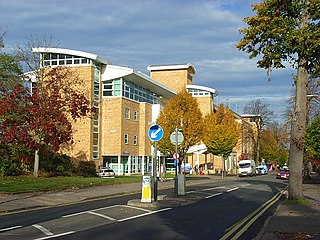
The Royal Berkshire Hospital (RBH) is an NHS hospital in the town of Reading in the English county of Berkshire. It provides acute hospital services to the residents of the western and central portions of Berkshire, and is managed by the Royal Berkshire NHS Foundation Trust.

The Countess of Chester Hospital is the main NHS hospital for the English city of Chester and the surrounding area. It currently has 625 beds, general medical departments and a 24-hour accident and emergency unit. It is managed by the Countess of Chester Hospital NHS Foundation Trust, one of the first Foundation Trusts in the UK, formed in 2004. Cardiac rehabilitation services at the hospital are provided by Cheshire and Wirral Partnership NHS Foundation Trust.
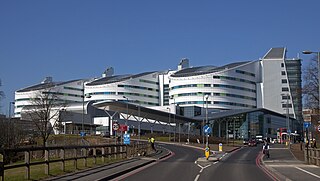
The Queen Elizabeth Hospital Birmingham is a major, 1,215 bed, tertiary NHS and military hospital in the Edgbaston area of Birmingham, situated very close to the University of Birmingham. The hospital, which cost £545 million to construct, opened on 16 June 2010, replacing the previous Queen Elizabeth Hospital and Selly Oak Hospital. It is one of the largest single-site hospitals in the United Kingdom and is part of one of the largest teaching trusts in England.

Southmead Hospital is a large public National Health Service hospital, situated in the area of Southmead, though in Horfield ward, in the northern suburbs of Bristol, England. It is part of the North Bristol NHS Trust. The 800-bed Brunel Building opened in May 2014, to provide services, which transferred from Frenchay Hospital in advance of its closure. The hospital site covers 60 acres (24 ha).

The Bristol Royal Infirmary, also known as the BRI, is a large teaching hospital in the centre of Bristol, England. It has links with the nearby University of Bristol and the Faculty of Health and Social Care at the University of the West of England, also in Bristol.

The James Cook University Hospital is a tertiary referral hospital and regional major trauma centre in Middlesbrough, North Yorkshire, England located on the A172. Having 1,046 beds, it caters for most specialities and forms part of the South Tees Hospitals NHS Foundation Trust, along with the Friarage Hospital in Northallerton.

The Royal Infirmary of Edinburgh (RIE) was established in 1729, and is the oldest voluntary hospital in Scotland. The new buildings of 1879 were claimed to be the largest voluntary hospital in the United Kingdom, and later on, the Empire. The hospital moved to a new 900 bed site in 2003 in Little France. It is the site of clinical medicine teaching as well as a teaching hospital for the University of Edinburgh Medical School. In 1960 the first successful kidney transplant performed in the UK was at this hospital. In 1964 the world's first coronary care unit was established at the hospital. It is the only site for liver, pancreas, and pancreatic islet cell transplantation in Scotland, and one of the country's two sites for kidney transplantation. In 2012, the Emergency Department had 113,000 patient attendances, the highest number in Scotland. It is managed by NHS Lothian.

Queen Elizabeth Hospital is a hospital in Woolwich in the Royal Borough of Greenwich. It was opened in March 2001 and serves patients from the Royal Borough of Greenwich and the London Borough of Bexley. The hospital was built to accommodate the services previously provided at Greenwich District Hospital and Brook General Hospital, and is a Private Finance Initiative hospital. It is managed by the Lewisham and Greenwich NHS Trust.
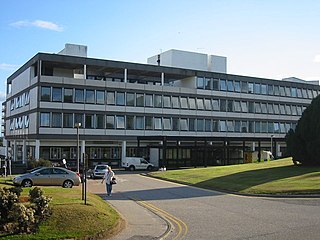
Aberdeen Royal Infirmary is the largest hospital in the Grampian area, located on the Foresterhill site in Aberdeen, Scotland. ARI is a teaching hospital with around 900 inpatient beds, offering tertiary care for a population of over 600,000 across the north of Scotland. It offers all medical specialities with the exception of heart and liver transplants. It is managed by NHS Grampian.

The Royal South Hants Hospital, known locally as "The RSH", is a community hospital in Southampton. It is managed by NHS Property Services.
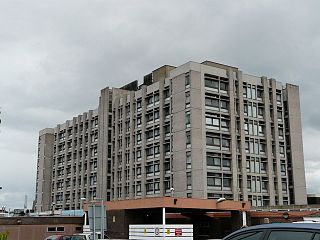
Doncaster Royal Infirmary is a district general hospital of 800 beds, located in Doncaster, South Yorkshire, England. It is managed by Doncaster and Bassetlaw Teaching Hospitals NHS Foundation Trust.
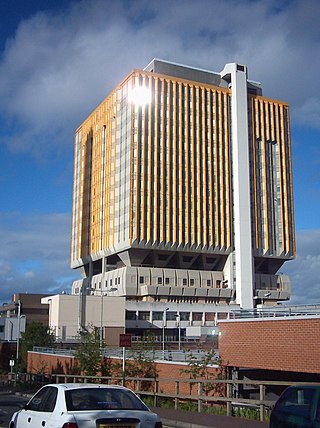
The Belfast City Hospital in Belfast, Northern Ireland, is a 900-bed modern university teaching hospital providing local acute services and key regional specialities. Its distinctive orange tower block dominates the Belfast skyline being the third tallest habitable storeyed building in Northern Ireland. It has a focus on the development of regional cancer and renal services. It is managed by Belfast Health and Social Care Trust and is the largest general hospital in the United Kingdom. In April 2020, due to the global coronavirus pandemic, the tower block was designated one of the UK's Nightingale Hospitals.

Gartnavel General Hospital is a teaching hospital in the West End of Glasgow, Scotland. The hospital is located next to the Great Western Road, between Hyndland, Anniesland and Kelvindale. Hyndland railway station is adjacent to the hospital. The name Gartnavel is derived from the Gaelic GartUbhal (apple) – i.e. "a field of apple trees". It is managed by NHS Greater Glasgow and Clyde.

Dumfries and Galloway Royal Infirmary is the main hospital in Dumfries and Galloway, Scotland. The hospital is managed by NHS Dumfries and Galloway.

University Hospitals of Leicester NHS Trust was created in April 2000 with the merger of the Leicester General Hospital, Glenfield Hospital and Leicester Royal Infirmary.

Royal Derby Hospital is one of two teaching hospitals in the city of Derby, the other being the Florence Nightingale Community Hospital. It is managed by the University Hospitals of Derby and Burton NHS Foundation Trust.

University Hospital Lewisham is a teaching hospital run by Lewisham and Greenwich NHS Trust and serving the London Borough of Lewisham. It is now affiliated with King's College London and forms part of the King's Health Partners academic health science centre. It is situated on Lewisham High Street between Lewisham and Catford.
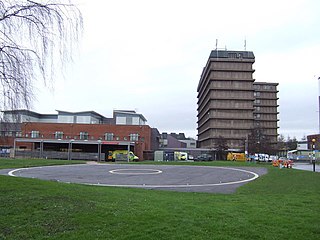
Gloucestershire Royal Hospital is an acute District General Hospital on the Great Western Road in Gloucester operated by the Gloucestershire Hospitals NHS Foundation Trust.

